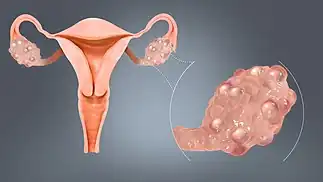Oligomenorrhea
| Oligomenorrhea | |
|---|---|
| Other names: Oligomenorrhoea | |
 | |
| Polycystic Ovaries (one cause of oligomenorrhoea) | |
| Specialty | Gynecology |
| Symptoms | Less than 9 menstrual periods per year.[1] |
Oligomenorrhea is infrequent menstrual periods.[1] Generally the menstrual periods occur at intervals of greater than 35 days, with less than 9 periods in a year, where previously there had been a regularly established pattern.[1] The period may be light or short in duration, and irregular.[1]
Causes
Oligomenorrhea can be a result of prolactinomas (adenomas of the anterior pituitary). It may be caused by thyrotoxicosis, hormonal changes in perimenopause, Prader–Willi syndrome, and Graves' disease.
Endurance exercises such as running or swimming can affect the reproductive physiology of female athletes. Female runners,[2][3] swimmers[4] and ballet dancers[5] either menstruate infrequently in comparison to non-athletic females of comparable age or exhibit amenorrhea. A more recent study shows that athletes competing in sports that emphasise thinness or a specific weight exhibit a higher rate of menstrual dysfunction than either athletes competing in sports with less focus on these or control subjects.[6]
Breastfeeding has been linked to irregularity of menstrual cycles due to hormones that delay ovulation.
People with polycystic ovary syndrome (PCOS) are also likely to have oligomenorrhea.[1] PCOS is a condition in which excessive androgens (male sex hormones) are released by the ovaries. People with PCOS show menstrual irregularities that range from oligomenorrhea and amenorrhea, to very heavy, irregular periods. The condition affects about 6% of premenopausal females.
Eating disorders can result in oligomenorrhea.[1] Although menstrual disorders are most strongly associated with anorexia nervosa, bulimia nervosa may also result in oligomenorrhea or amenorrhea. There is some controversy regarding the mechanism for the menstrual dysregulation, since amenorrhea may sometimes precede substantial weight loss in some anorexics.
References
- 1 2 3 4 5 6 Riaz, Yumna; Parekh, Utsav (2023). "Oligomenorrhea". StatPearls. StatPearls Publishing. PMID 32809410. Archived from the original on 2023-03-04. Retrieved 2023-11-05.
- ↑ Dale E, Gerlach DH, Wilhite AL (1979). "Menstrual dysfunction in distance runners". Obstet Gynecol. 54 (1): 47–53. doi:10.1097/00006250-197907000-00013. PMID 313033.
- ↑ Wakat DK, Sweeney KA, Rogol AD (1982). "Reproductive system function in women cross-country runners". Med Sci Sports Exerc. 14 (4): 263–9. doi:10.1249/00005768-198204000-00002. PMID 7132642.
- ↑ Frisch RE, Gotz-Welbergen AV, McArthur JW, et al. (1981). "Delayed menarche and amenorrhea of college athletes in relation to age of onset of training". JAMA. 246 (14): 1559–1563. doi:10.1001/jama.246.14.1559. PMID 7277629.
- ↑ Warren MP (1980). "The effects of exercise on pubertal progression and reproductive function in girls". J. Clin. Endocrinol. Metab. 51 (5): 1150–1157. doi:10.1210/jcem-51-5-1150. PMID 6775000.
- ↑ Torsiveit, MK (2005). "Participation in leanness sports but not training volume is associated with menstrual dysfunction: a national survey of 1276 elite athletes and controls". British Journal of Sports Medicine. 39 (3): 141–147. doi:10.1136/bjsm.2003.011338. PMC 1725151. PMID 15728691.
External links
| Classification |
|---|